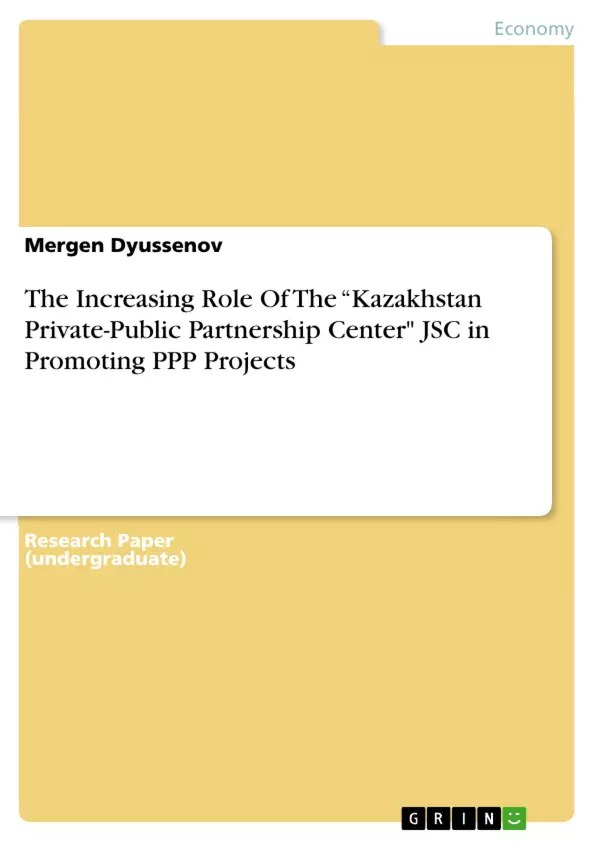This research paper aims at analyzing the role of “Kazakhstan Private-Public Partnership Center” established in 2008, through the prism of the existing, as well as the newly emerging, legal framework on PPPs; the roles of the Kazakh government and key stakeholders primarily the Ministry of Economic Development and Trade, and the Ministry of Finance.
The paper also explores the risks associated with implementing PPP projects in the context of Kazakhstan, generally divided into public sector, private sector, and common risk groups. A selected number of project cases are presented to better illustrate the evolution of PPP projects before and after the PPP Center was established. The ultimate research question the paper attempts to answer is what impact the introduction of the PPP Center has made on implementing PPP projects in Kazakhstan.
Inhaltsverzeichnis (Table of Contents)
- I. Definitions in the PPP Context of Kazakhstan..
- II. Brief Overview of the PPP Legal Framework in Kazakhstan..
- III. PPP Center JSC.
- IV. Selected Project Cases.
- 4.1 Prior to establishment of the PPP Center..
- 4.1.1 The Shar-Oskemen railway project
- 4.2 After/Around 2008 establishment of the PPP Center
- 4.2.1 The BAKAD (Almaty Ring Road) Project
- 4.2.2 Construction of the Korgas-Zhetygen Railway Line.
- 4.1 Prior to establishment of the PPP Center..
- V. Analysis of Risks Applied to Concession Projects in Kazakhstan
- VI. Research Findings..
Zielsetzung und Themenschwerpunkte (Objectives and Key Themes)
This research paper examines the role of the “Kazakhstan Private-Public Partnership Center” established in 2008, analyzing its impact on implementing PPP projects in Kazakhstan. The paper considers the existing and emerging legal frameworks, the roles of the Kazakh government and key stakeholders, and the risks associated with PPP projects in the country. The study also presents case studies to illustrate the evolution of PPP projects before and after the PPP Center's establishment.
- Role of the “Kazakhstan Private-Public Partnership Center”
- Legal framework and its impact on PPP projects
- Government and stakeholder roles in PPP implementation
- Risks associated with PPP projects in Kazakhstan
- Evolution of PPP projects in Kazakhstan
Zusammenfassung der Kapitel (Chapter Summaries)
The paper begins by defining PPPs in the context of Kazakhstan, highlighting the prevalence of the concession model, particularly the build-operate-transfer (BOT) structure. The chapter explores the benefits of PPP implementation, including cost effectiveness, time efficiency, and risk sharing. It also discusses the hierarchy of various PPP models, placing "operations concessions" within the framework of private sector involvement.
The second chapter provides a brief overview of the legal framework surrounding PPPs in Kazakhstan, tracing its development from the early 1990s. The chapter discusses the evolution of concession laws and the impact of the 2006 Civil Code on PPP projects. It also highlights key projects implemented during this period, including the Shar-Oskemen railway project and the "North Kazakhstan Aktobe" inter-regional power line.
The third chapter focuses on the “Kazakhstan Private-Public Partnership Center” (PPP Center), outlining its establishment and purpose. The chapter explores the center's role in providing methodological and methodical support for the implementation of concession projects. It also examines the center's contribution to the development of PPP projects in Kazakhstan.
The fourth chapter presents case studies of selected PPP projects, illustrating the evolution of PPP projects both before and after the establishment of the PPP Center. The chapter examines the Shar-Oskemen railway project, the BAKAD (Almaty Ring Road) Project, and the construction of the Korgas-Zhetygen Railway Line, highlighting the impact of the PPP Center on these projects.
The fifth chapter delves into the analysis of risks associated with concession projects in Kazakhstan. The chapter classifies risks into public sector, private sector, and common risk groups, providing insights into the challenges and complexities of implementing PPP projects in the country.
Schlüsselwörter (Keywords)
Public-Private Partnerships (PPPs), Kazakhstan, Concession, Build-Operate-Transfer (BOT), Legal Framework, PPP Center, Risk Analysis, Infrastructure Development, Economic Development, Investment Climate, Stakeholder Management, Case Studies.
- Quote paper
- Mergen Dyussenov (Author), 2017, The Increasing Role Of The “Kazakhstan Private-Public Partnership Center" JSC in Promoting PPP Projects, Munich, GRIN Verlag, https://www.grin.com/document/356446



